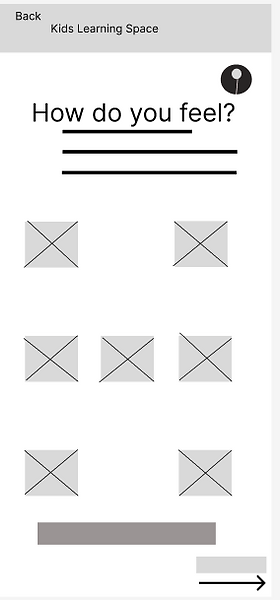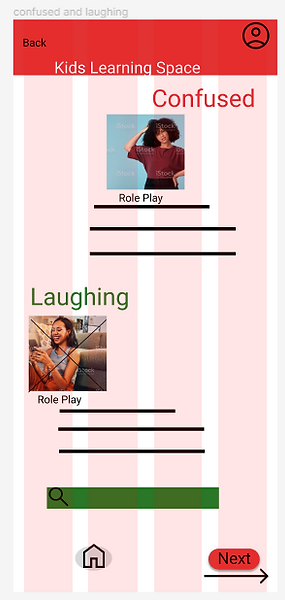
Problem Statement
The problem I was trying to solve was helping kids at their early age of development learn about their emotions. I see the social need of education here. Neelam is a troubled kid who needs to understand what emotions are and what they are because she is just in her early stages of development and she is expressing herself.
The goal here was for the kids to learn about their emotions and understand them. I want to drive positive change in society by giving kids an understanding about each emotion they have. My role in this is UX designer and researcher.
Paper and Digital Wireframes: Design Emotions for




High Fidelity Prototypes





Case Study
-
There will be 4 Participants are all kids, they are in second grade and all learning about emotions.
-
1 boy, 1 girl, 2 twin: one is visually impaired in one eye and the other is in a wheelchair
-
I chose these participants because they will help me understand how kids behave with my app.
-
They are allowed to use screenreaders
Design a service to help kids
-
Learn about emotions.
-
Stakeholders: 2nd grade kids learning their emotions, Chloe Scot-lead UX designer, VP of design-Mark Wein.
-
Project background: I wanted to conduct this research because I wanted to teach kids their emotions and how to understand emotions.
-
KPI's:
-
Time on Task: How long do kids take to understand their emotions and keep icons.
-
User error rates: How often do the kids make mistakes ‘understanding which emotion is which.
-
Conversion rate: Number of users who are able to know their emotions after the app usage.
-
METHODOLOGY:
-
Moderated Usability study and I will analyze data by giving a survey.
-
Location: United States; The study will be conducted in Atlanta, Georgia.
-
Date: The study will take place on June 13th and June 17th in the daytime at normal hours.
-
Length: The session will last 30 minutes.
-
Compensation: Give the kids lollipops for participating.
-
The methodology should be detailed so that other researchers can understand what you did, the choices you made, and the limitations of the methods employed to decide if or when further research is needed.
-
Research goals: What design problems are you trying to solve for the user and/or the business? How will the results of the research affect your design decisions? The problem here is that kids cannot define their emotions on the app. They don’t understand how to know what emotions are being played. It is my job to make them use the app more effectively. The results of the research will affect my design decisions because it will help me keep or remove certain icons for kids to understand their emotions. I need to balance my emotions and understand them.
-
Are kids able to understand their emotions after they finish using this app? -How do you feel about understanding your emotions when you use this product? -Is this product easy to use for kids in general?
-
Are there any potholes or misunderstanding of emotions especially for the kids?
-
How can I solve the challenges you have especially when the kids are trying to learn their emotions?
How can you measure progress toward the research goals?

.png)
